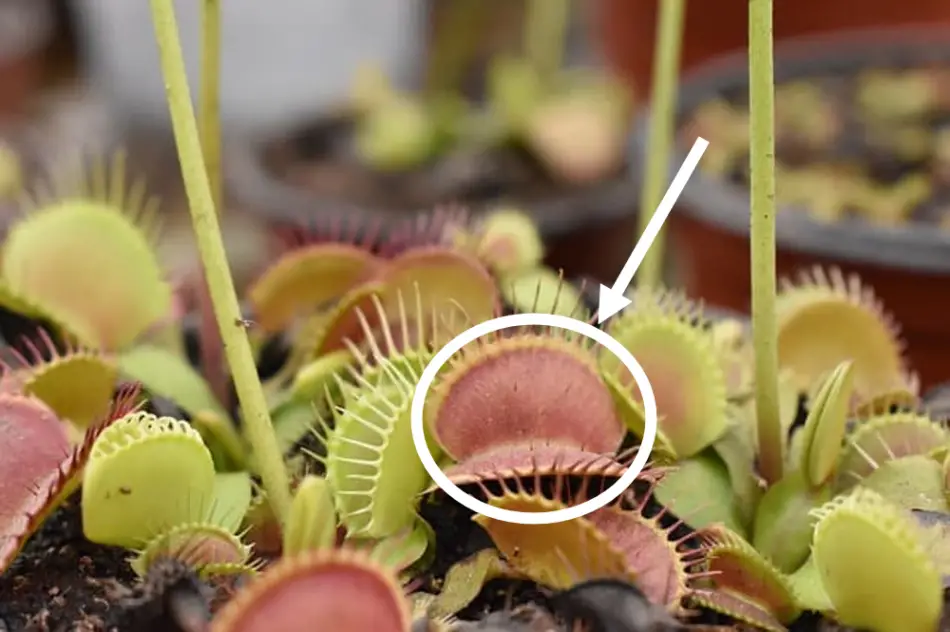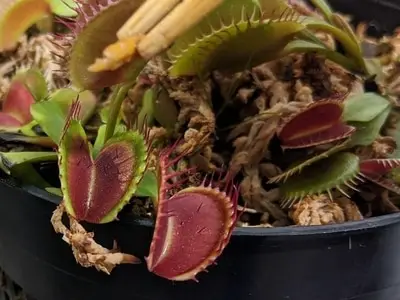In the wild, Venus flytraps capture and consume insects. Insects are packed with nutrients, very helpful to Venus flytraps. But, do Venus flytraps need to eat to stay alive? or to stay healthy?
Venus flytraps do not need to consume bugs to live or to stay healthy. The nutrients Venus flytraps extract from bugs supplement their diet but are not required. A Venus flytrap can live without ever consuming an insect. Still, regular access to bugs is beneficial for the plant’s development.
Venus flytraps, like all other plants, make their own food through photosynthesis. They can stay alive as long as they have enough access to sunlight, water, and airflow for photosynthesis.
Venus flytraps consume bugs because they grow in nutrient-poor areas. Since they are unable to gather nutrients from the soil, they extract them when they consume insects.
In the outdoors, Venus flytraps can capture plenty of prey.
Having regular access to bugs is beneficial for Venus flytraps. The nutrients they extract from insects encourage growth and rhizome divisions. Venus flytraps do not need to eat every day to exhibit the positive effects of consuming bugs. A single insect every month can make a difference.
One of the misconceptions out there about Venus flytraps is that they need to eat lots of bugs. Venus flytraps can live with no bugs at all and benefit from the occasional meal.
Do Venus Flytraps Need To Be Fed?
Venus flytraps can consume insects, but they do not need to be fed.
Venus flytraps growing outdoors capture their own meals. They are effective predators.
When growing Venus flytraps, consider placing them outdoors, where they have plenty of access to insects and sunlight.
Indoor plants might still capture some bugs. However, it is less likely. If you grow your Venus flytrap indoors, consider feeding it every once in a while to encourage growth.
Before you attempt to feed your Venus flytrap, make sure you do some research. If done incorrectly, feeding a Venus flytrap can actually harm it.
A section below in this article explains the feeding process.
What Happens If a Venus Fly Trap Doesn’t Eat?
Venus flytraps benefit from consuming bugs, but what would happen if they stop eating.
Venus flytraps do not exhibit negative signs when they do not eat; they can continue to be healthy plants without consuming bugs. However, Venus flytraps that receive occasional feeding tend to develop faster, divide into multiple plants, and grow larger traps.
When Venus flytraps do not eat, nothing significant happens. There are no adverse effects. Venus flytraps can continue growing at a standard rate as long as they have good daily exposure to sunlight (plus other care considerations).
Instructions on How To Feed a Venus Flytrap
Feeding a Venus flytrap is optional. Outdoor Venus flytraps do not need to be fed at all but can be fed just for fun. And, indoor Venus flytraps can benefit from consuming bugs.
Venus Flytrap Feeding Instructions
Follow the instructions below to feed a Venus flytrap without harming it.
1.-Select the prey: Employ a bug that can fit entirely inside your plant’s trap. As a rule of thumb, choose an insect that is maximum, 1/3 of the size of the trap.
Venus flytraps can consume almost any insect, such as a fly, cricket, worm, slug, and ant. Preferably, avoid hardshell insects such as beetles or snails to ease the digestion process.
You can employ live or dead insects to feed a Venus flytrap. However, using dead prey is slightly more involved. This article on Venus flytrap feeding has more information about both processes. For simplicity, this article will focus on employing live insects.
For more information on where to get the bugs to feed your plant, check out this article: Venus flytrap best food options.

2.-Locate the trigger hairs: Each leaf in a Venus flytrap is made up of two lobes. There are three trigger hairs arranged in a triangular pattern in the interior of each of those lobes.
The traps in your plant won’t close unless something comes in contact with those trigger hairs twice in a short period of time.
Sometimes it is hard to see the trigger hairs, but you should try to locate them.
3.- Grab the prey and drop it: Get a handle on the bug you want to use. You can use your hands or a tool to grab it. Some people use tweezers; I use chopsticks.
Take your time getting the bug under control. Once you are ready, get the insect as close as possible to the trap and the trigger hairs, and drop it right on top.
4.- Make the trap close: In most cases, live bugs will automatically activate the traps by coming in contact with the trigger hairs. However, in some cases, the insects might try to escape before the trap closes.
If the trap does not close right away, use your fingers or a tool to brush those trigger hairs a few times. The trap should close immediately after that.
5.- Wait for a few minutes: Once the trap is closed, your job is almost done! The bug will move around the trap and prone the Venus flytrap to close tighter and tighter and start producing enzymes.
It takes 5-10 minutes for the trap to fully close.
5.- Monitor the trap: After you fed your Venus flytrap, it will start digesting the bug. At this point, you do not need to do anything. Still, I always suggest looking at the leaf you fed and monitor it. If the leaf turns brown, it is often a clue that the bug was too big or hard to digest.
After a Venus flytrap captures an insect, it takes several days or even weeks to digest it. After it is done, the trap will reopen.
In most cases, the traps reopen and exhibit the leftovers from the bug, such as the exoskeleton. You do not need to remove the remains of the prey. Just leave it there. Sometimes rain washes it over.
Venus Flytrap Feeding Dos and Don’ts
- Avoid feeding Venus flytraps during dormancy (winter season, inactivity period)
- Only feed one trap of the entire time at a time
- Only feed your plant when it has finished consuming any previous meals
- Feed your Venus flytrap once every 3 to 6 weeks. Waiting a few weeks during feeding will help you avoid overfeeding.
- There is no need to feed seedlings or very tiny Venus flytraps. Do not attempt unless you have a specific method to do so.
- Observe the trap you fed the days following the feeding. If the leaf turns black, it is possible that the bug was too large for the trap. Black leaves can be a sign of incorrect feeding.
Now, the biggest don’t when feeding a flytrap…
Do Venus Fly Traps Only Eat Bugs?
Venus flytraps are carnivorous plants; therefore, they can consume meat. However, you must never attempt to feed meat, chicken, hamburgers, or any human food to Venus flytraps. The plant won’t be able to digest the food, and it will end up rotting.
You must also avoid feeding candy or fruit to Venus flytraps. Stick to an insect-only diet, and your plant will remain healthy.
Before you feed your plant, make sure you have earned at least the basics of the feeding process. Since feeding is not a requirement, it would be counterproductive to feed your plant incorrectly and end up hurting it.
I hope you found this article informative. You can find much more information on Venus flytrap care in this detailed guide: Ultimate Venus Flytrap Care Guide – Free Care Sheet Included. And, for Venus flytraps growing indoors, this article can help you build the correct setup: Venus Flytrap Indoor Care Guide.


